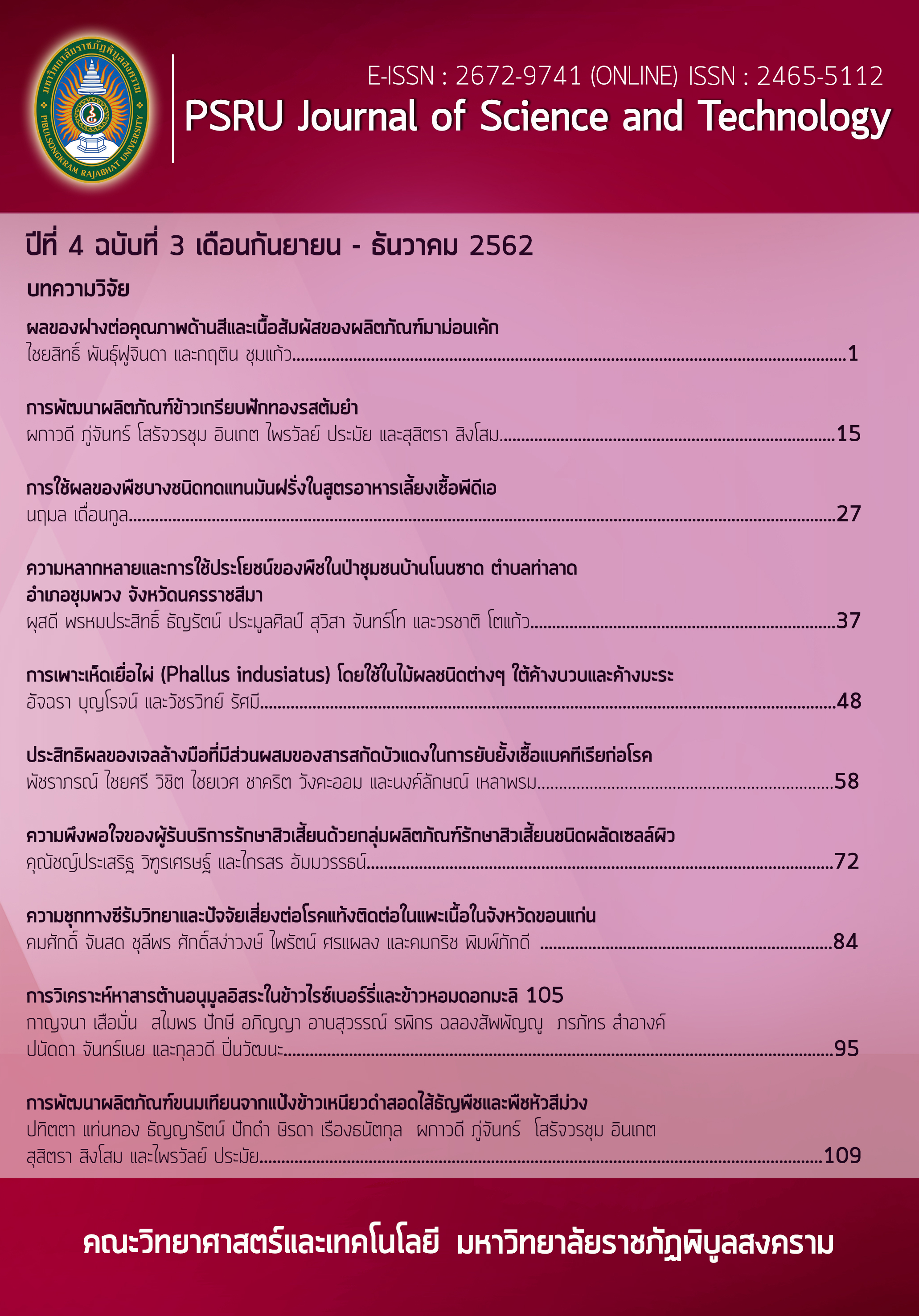EFFECT OF HAND CLEANSING GEL MIXED THE CRUDE EXTRACT OF NYMPHAEA LOTUS L. IN INHIBITING PATHOGENIC BACTERIA
Keywords:
Hand cleansing gel, Nymphaea lotus L. extracts, Antibacterial activityAbstract
The objectives of this research were to determine the antimicrobial activity of hand cleansing gel mixed with water lily (Nymphaea lotus L.)extract. Petal and pollen of Nymphaea lotus L. were extracted with serial different solvent: hexane, ethyl acetate, methanol and water. Antibacterial activity of crude extracts from petals and pollen were preliminarily examined against bacteria using E.faecalis, E.Coli ATCC 25922 K. Pneumonia P. Aeruginosa ATCC 27853 S. typhimurium, S. aureus ATCC 29213 S. epidermidis ATCC 35984 and V. cholerae by agar well diffusion method. Minimal inhibitory concentration (MIC) and minimal bactericidal concentration (MBC) were tested by using broth dilution method. The ethyl acetate extracts from petals and hexane extracts from pollen were the best to inhibit gastrointestinal bacteria. However, hand cleansing gel mixed the ethyl acetate extracts from petals inhibited all 4 strains bacteria; E. Coli ATCC 25922 S. epidermidis ATCC 35984 V. cholerae and S. aureus ATCC 29213. Hexane extracts from pollen mixed hand cleansing gel only inhibited E. Coli ATCC 25922 S. epidermidis ATCC 35984 and V. cholerae but it not found inhibited S. aureus ATCC 29213. The results of this study revealed that the potential uses of the extracts of native medicinal plants can develop to hand cleansing gel for inhibiting pathogenic bacteria and uses as prevention for bacterial infections.
References
เอทานอล. วารสารวิทยาศาสตร์และเทคโนโลยี หัวเฉียวเฉลิมพระเกียรติ, 1(2), 56-65.
ตรีเพชร กาญจนภูมิ. (2552). เคมีของสมุนไพร. กรุงเทพฯ: สำนักพิมพ์แห่งจุฬาลงกรณ์มหาวิทยาลัย.
นิตยาจาร กิตติเดชา และคณะ. (2546). การปองกันการติดเชื้อและควบคุมการแพรกระจายเชื้อ Isolation precautions. กรุงเทพฯ:
องคการรับสงสินคาและพัสดุภัณฑ์.
บวรพงศ์ พรชุติ. (2548). เจลล้างมือ. มหา(นคร)สาร, 13(4), 24-28.
บุหรัน พันธุ์สวรรค์. (2545). การศึกษาฤทธิ์ต่อต้านอนุมูลอิสระในผักช้าเลือด. วิทยานิพนธ์ปริญญาโท (สาขาวิชาวิทยาศาสตร์
สิ่งแวดล้อม คณะวิทยาศาสตร์) มหาวิทยาลัยนเรศวร.
บังอร วงศ์รักษ์ และศศิลักษณ์ ปิยะสุวรรณ์. (2549). ฤทธิ์ต้านอนุมูลอิสระของผักพื้นบ้าน. โครงการพิเศษปริญญาตรี (ภาควิชา
เภสัชวิทยา คณะเภสัชศาสตร์) มหาวิทยาลัยมหิดล.
ปิยะวดี เจริญวัฒนะ สุมนาปานสมุทร ดำรงคงสวัสดิ์ และอำนวย เพชรประไพ. (2552). การศึกษาฤทธิ์ในการยับยั้งเชื้อจุลินทรีย์ของ
สารสกัดจากบัวหลวง. รายงานวิจัย มหาวิทยาลัยเทคโนโลยีราชมงคลธัญบุรี.
รองเดช ตั้งตระการพงษ์ และจุลจิตร์ ตั้งตระการพงษ์. (2556). ฤทธิ์ต้านเชื้อแบคทีเรียของสารสกัดยี่หร่า. วารสารวิทยาศาสตร์ แห่ง
มหาวิทยาลัยราชภัฏเพชรบุรี, 13(2), 40-46.
Cockerill FR, Hindler JA, Wikler MA, Patel JB, Alder J, Powell M, et al. (2012). Clinical and Laboratory Standards
Institute. Performance standards for antimicrobial disk susceptibility tests; Approved standard-eleventh
edition. CLSI document M02-A11, 32(3), 1-31.
Dan-Dan Yin, Ru-Yu Yuan, Qian Wu, Shan-Shan Li, Shuai Shao, et al. (2015). Assessment of flavonoids and volatile
compounds in tea infusions of water lily flowers and their antioxidant activities. Food Chemistry, 187(6),
20-28.
Wen-Rui D, Liang-Liang Z, Sai-Sai F, Jian-Guo X. (2014). Chemical composition, antibacterial activity and mechanism of
action of the essential oil from Amomum kravanh. J Food Prot, 77(10), 1740-1746.
Downloads
Published
How to Cite
Issue
Section
License
กองบรรณาธิการขอสงวนสิทธิ์ในการปรับปรุงแก้ไขตัวอักษรและคำสะกดต่างๆ ที่ไม่ถูกต้อง และต้นฉบับที่ได้รับการตีพิมพ์ในวารสาร PSRU Journal of Science and Technology ถือเป็นกรรมสิทธิ์ของคณะวิทยาศาสตร์และเทคโนโลยี มหาวิทยาลัยราชภัฏพิบูลสงคราม และ
ผลการพิจารณาคัดเลือกบทความตีพิมพ์ในวารสารให้ถือมติของกองบรรณาธิการเป็นที่สิ้นสุด







